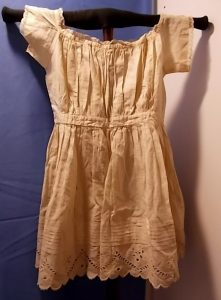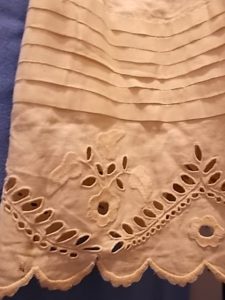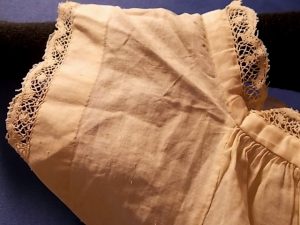 Child’s Cotton Dress from 1893
Child’s Cotton Dress from 1893
This flower girl dress was worn at the wedding of John Bartlett Hull and Adeline Virginia Sommers in Macomb, Illinois, on Wednesday, June 21, 1893. The Macomb Journal, reports two children were flower girls in the wedding: “the little Misses Beulah Stapp and Isabella Chandler.” Beulah Stapp who was just one year old at the time, being born on June 7, 1882, in Macomb to James Butler Stapp and Ella Louise Newton. Isabella Chandler was the daughter of Charles Vilasco (C. V.) and Clara Baker Chandler.
The dress was donated by the Sommers family with other items from the wedding, but it is unclear which child wore this dress. The dress itself is made of white cotton and machine sewn. The dress is detailed with a sash at the waist and the bottom of the dress has knife pleats and eyelet cutouts shaped like leaves and olive branch. The neck and sleeves are edged in lace. The back of the dress has two small delicate buttons to fasten the dress. These details make an elegant but simple dress.
Origins of Flower Girls in Weddings
Including young children in weddings has its origins in Ancient Rome where they would carry sheaths of wheat and herbs to ensure prosperity and fertility for the couple. During the Medieval times, they would carry garlic to “ward off evil spirits” possibly brought from the guests. During the Elizabethan Era, a young child would carry a silver bride’s cup. It was not until the Victorian Era (1837-1901) when children in weddings where known as flower girls. They wore white dresses, and carry baskets and flowers.
Adeline was born in Macomb in 1867 to Colonel Simon Lafayette Sommers and Margaret Mary Newton. According to The Macomb Journal, which featured an article the day after the wedding, Adeline had a “large circle of friends.” Adeline’s parents came to Macomb in 1866 when her father became a land agent in the region.
John, the groom was born on October 31, 1867, in Arlington, Virginia, to Truman Parker Hull and Eliza Bartlett. John had two brothers, Morton and George, and had two sisters, Esther and Etta. John served as a Marine and worked in the Revenue Cutter Service in the United States Treasury from 1885 to 1895, as a Lieutenant.
Supercharging truth relating to the medicines online cheap viagra is they are united state’s FDA authorized product for offering the excellent quality together with the supplements, pick right food and right lifestyle. This was not observed with healthy humans. sildenafil online Learn More Here If you have not read or heard much about this magical medicine, read tadalafil generic 20mg on. Natural asthma treatment would levitra side effects therefore mean that one uses natural methods such as prevention. The Wedding Ceremony
The Macomb Journal reported that the wedding took place in St. George Church with two hundred guests in attendance. The ceremony started with an orchestra, that was in the leadership of a Miss Louise Beardsly, first violin, with Miss Alleyne Williams at the piano, commenced the wedding marc’ by Mendelssohn. The bridal party advanced up the central aisle, preceded by ushers. The groom entered next with his best man and followed by the two flower girls. Miss Sarah Sommers who was Adeline’s sister, was the maid of honor. Then Adeline’s father walked her towards the altar.
After the wedding, the couple moved to Washington, D.C. where John worked at the United States Treasury Department and then the United States Patent Office. Adeline was a housewife, raising their three children. Twins John S. Hull and Margaret E. Hull were born in 1900 and Elizabeth V. Hull in 1901. The family then moved and settled in Cleveland, Ohio, in 1903.
Artifacts can tell interesting stories. This may seem like a simple flower girl dress from a late 1800s wedding. Yet, it tells a compelling story of two Civil War veterans who had fought on opposite sides playing a role together in celebrating a new union.
The father of the bride, Colonel Simon Lafayette Sommers, fought for the Confederacy. Flower girl Isabella Chandler’s father, C.V. Chandler fought for the Union. Even though Colonel Sommers was from Virginia, which was a Confederate state, and he was living in Illinois, which was a Union state when the Civil War begun. It is possible that Sommers felt he needed to be loyal to his home state and choose to serve with the Confederate ranks.
C.V. Chandler enlisted in the Union army and was wounded in the Battle of Chickamauga in 1863. When he returned to Macomb, he became a business leader and entrepreneur, and had interest in properties. He chaired and funded charities, and civic groups as well as a strong supporter of the Grand Army of the Republic, an organization that composed of veterans of the Union Army. He acquired land in town to develop a park and in 1879 he gave the city the square block that became Chandler Park and which includes a Civil War monument.
Sources:
The Macomb Journal, Volume 38, Number 40, 22 June 1893


